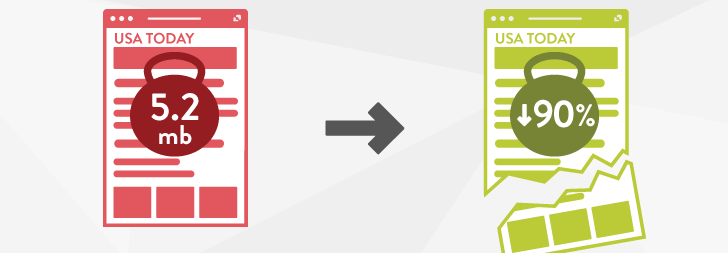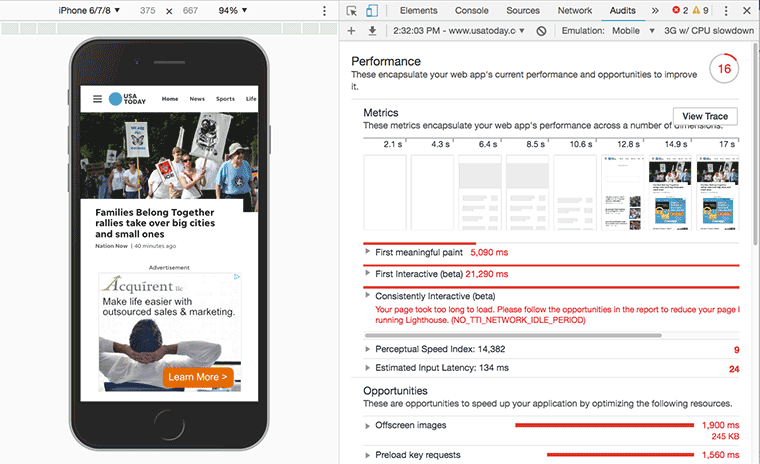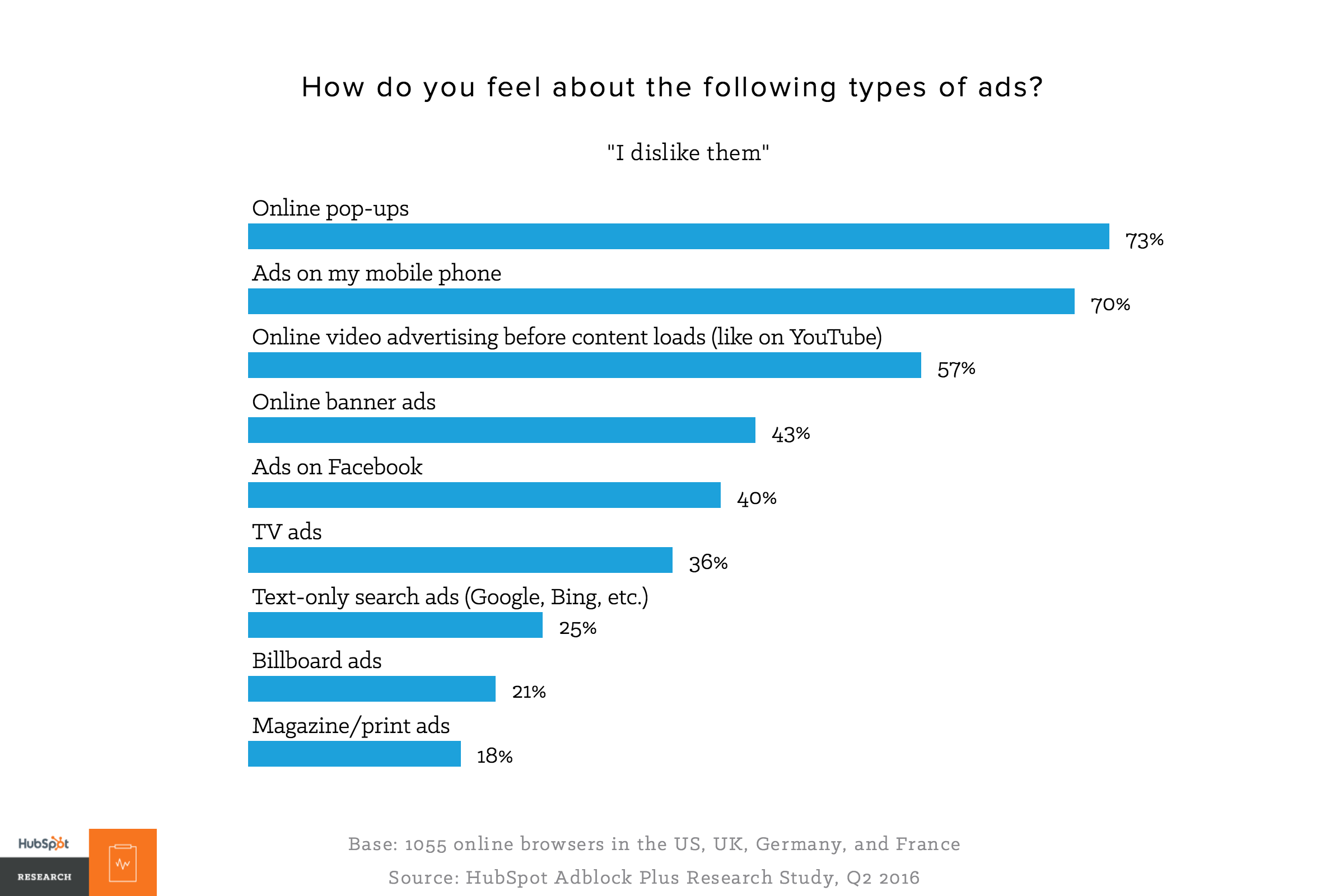Is GDPR Good for the Environment?

In this post, we explore how the European Union’s new privacy legislation could lead to a higher performing internet that not only maintains user privacy, but also burns less energy while providing a better experience for everyone. Sounds great, right?
On May 25, 2018—the day GDPR, the General Data Privacy Regulation, went into effect across Europe—Austrian web developer Marcel Freinbichler noticed that the separate, GDPR-compliant website popular news outlet USA Today created for EU users was significantly faster than the original. Upon further inspection, he found that, with all its tracking codes removed, the GDPR-compliant site was one-tenth of its original size and page load time dropped from 45 seconds to three seconds.
Because of #GDPR, USA Today decided to run a separate version of their website for EU users, which has all the tracking scripts and ads removed. The site seemed very fast, so I did a performance audit. How fast the internet could be without all the junk! 🙄
5.2MB → 500KB pic.twitter.com/xwSqqsQR3s— Marcel Freinbichler (@fr3ino) May 26, 2018
This difference is significant with ramifications the could impact many things. Let’s explore why.
Beyond GDPR
Within the first few days after GDPR went into effect, lawsuits against Google and Facebook alone added up to $8.8 billion with numerous others following suit. Meanwhile, some companies such as The LA Times, The Chicago Tribune, and The New York Daily News told visitors that their sites are “currently unavailable in most European countries”, choosing to ignore the 500 million people in Europe (roughly one and a half times the size of U.S. population) rather than comply with GDPR. Other websites offer users the ability to opt out of tracking altogether. Though this typically manifests itself in an annoying pop-up, it should ostensibly offer users who opt-out a better, faster experience. More on that in a bit.
GDPR has received most of the press due to its extensive conditions and far-reaching implications, but there are other efforts underway as well. With the general public increasingly skeptical over how websites and tech companies use our personal data—especially with the large number of data breaches that have occurred in recent years and scandals like the Cambridge Analytica-Facebook debacle—lawmakers have introduced a flurry of security- and privacy-related legislation. Whether any of these bills turn into law remains to be seen, but when combined with increasing public skepticism and the financial motivation of lawsuits, there are larger implications regarding how companies will collect and use our data in the future. This will undoubtedly impact how we experience the internet.
People Leave Slow Sites
According to a report from Google, the majority (53%) of mobile users will leave a site that doesn’t load in under three seconds. Since most web surfing is done on mobile devices, this could have direct implications to an organization’s bottom line in the form of lost advertising, e-commerce, or subscription revenue. Plus, fast-loading websites offer users better experiences, increasing their likelihood of returning or completing a transaction. Organizations that do business online—which is most of them these days—should be motivated to serve up speedy sites that get users to the content they need quickly and without barriers, yet for many, this remains a low priority.

Perhaps USA Today and other publications will pay attention to those who appreciate their leaner, faster, GDPR-compliant website and make similar decisions in the future.
Speaking as a user — THIS 500 KB site is the web I want.
Speaking as an architect of the web — I keep thinking that we’ve built a platform that is serves, in this example: 9% content, 91% ads and tracking.
1/6
(@w3ctag) https://t.co/GwT4NeSePT
— Hadley Beeman (@hadleybeeman) May 26, 2018
Slow Sites Use More (Mostly Coal-Powered) Energy
Web developer and digital sustainability expert Chris Adams noted that the USA Today example has environmental ramifications too. In his post, How Much CO2 Can You Save When You Remove Ad-Tracking From News Sites Mr. Adams calculated that, given its monthly traffic volume, the lighter USA Today site saves about as much CO2 daily as a flight from Chicago to New York. On a monthly basis:
For a site like USA Today, it looks like running the ‘GPDR-lite’ version as the default would represent CO2 emissions savings equivalent to an entire European person’s annual carbon footprint, each month.
Full estimates as well as a breakdown of how they were calculated are in the link above. The internet is, in effect, the world’s largest coal-powered machine. It has an environmental impact greater than that of the commercial airline industry. Powering it with 100% renewable energy won’t happen tomorrow, but should be a goal we work toward reaching as quickly as possible.
In the meantime, those of us who build the web for a living have a responsibility to make it as efficient as we can and power it with renewables when possible. If every one of the more than half-million agencies worldwide committed to building lightweight digital products similar to USA Today‘s GDPR site, for example, we could significantly reduce greenhouse gas emissions warming up our planet.
The Ad-Bloated Internet
News sites are particularly notorious for sacrificing user experience in the name of eking out a few extra dollars by way of ads that few people intentionally click on. According to Hubspot’s research, the majority of people dislike pop-up ads, mobile ads, and video ads (the kind that play while you’re waiting for a video) the most, with online banner ads and Facebook ads not far behind. Per the Google report mentioned above, average ad size is about 816 KB, which takes four seconds to load over a fast 3G connection. If your pages each serve multiple ads, this can add up, causing potential customers or donors to leave quickly.

Plus, when websites also use dark patterns—UX tactics meant to intentionally deceive, such as those employed by Google, Microsoft, and Facebook—they offer experiences that are not only slow but aggravating as well. In fact, the Hubspot research referenced above noted that 34% of respondents clicked on an ad by mistake while 15% said the ad intentionally tricked them into clicking on it. Shameful.
For more details on just how bad news sites are for both user experience and internet sustainability, check out Andrew Boardman’s great presentation from the 2016 Sustainable UX conference below:
News outlets struggle with monetization. Consumers should support online journalism by buying subscriptions to the publications we trust whose content we value. As a former journalist, I believe this. Unfortunately, with a glut of online content freely available, few people actually do that. Thus, ad-free news sites are probably not realistic. However, if your site serves up slow, ad-laden pages that undermine user experience, your customers are, without fail, going to look for faster, more viable alternatives. I use the weather app native to iOS, for example, because The Weather Channel app is slow, clunky, and bogged down with ads I don’t want to see. No thanks. We need to find viable methods for news outlets to thrive while also providing customers what they need quickly and without barriers. Web pages overloaded with ads are not the answer.
Do Better Options Exist?
Until we figure out less intrusive ways to monetize online content, ads probably aren’t going away anytime soon. However, there are plenty of things anyone can do to make sure their content loads quickly and provides a better experience for users. Here are some examples.
Optimize Your Ads (And the Systems Running Them)
In Mightybytes’ early days, our banner ad projects had to weigh in below 15 kb. Oftentimes, this size constraint included animation too. Current average ad sizes are more than 54 times that. If your site runs ads, there are still plenty of opportunities to reduce ad file size in ways that maintain quality but improve user experience as well.
- Work with ad platforms, agencies, and media buyers to make sure ad content is optimized for low-bandwidth by replacing videos with static images, optimizing file sizes, and so on.
- Serve fewer ads per page and make sure systems are optimized to only serve ads if user bandwidth will support them.
- In addition to ads, minimize the number of ad-tracking systems you use per page.
Optimize Your Content
Outside of ads, you can still optimize the remaining content on a page. Here are just a few ways:
- Optimize images and other media content to reduce file size without reducing quality.
- Use a page weight budget to ensure each page is optimized for best performance.
- Replace image carousels, video backgrounds, and other bandwidth-intensive content with lower bandwidth alternatives.
- Avoid autoplay on video, audio, or any media files. Also, don’t use proprietary playback technology.
- Ditch pop-ups of any kind. They are annoying and can really mess with user experience, especially on older devices or in low-bandwidth areas.
Design for Sustainability
Follow sustainable web design practices outlined on our microsite and in our book Designing for Sustainability: A Guide to Building Better Digital Products and Services. In its simplest form, the four-part framework includes:
- Performance optimization: Get the fastest possible performance from your pages by optimizing content, assets, scripts, and server response time.
- UX Design: Ensure users can accomplish tasks as quickly as possible and without any barriers to completion.
- Findability and SEO: Help users find the content they need as quickly as possible by following best content strategy, information architecture, and SEO practices.
- Green Hosting: Use the Green Web Foundation’s directory to find a webhost that powers their servers with renewable energy.
Also, in addition to the practices mentioned above, a more sustainable website supports your organization and its stakeholders for the long haul while embracing triple bottom line principles and perhaps even helping you reach some of the U.N. Sustainable Development Goals. It should also be accessible to people with disabilities and follow privacy and security best practices as well.
GDPR is Good for People and Planet
There are nearly 2 billion websites on the internet right now. If even half of these sites improved performance by 90%, as USA Today did with their GDPR site, we could significantly reduce web-based CO2 emissions while also providing faster, better experiences for all users. If this is a by-product of GDPR and similar regulations, count us in.
If you’d like help making your own website or digital product faster, check out our website performance optimization services or drop us a line via our contact form.
Digital Carbon Ratings, now in Ecograder.
Understand how your website stacks up against industry carbon averages with this new feature.
Try Ecograder


